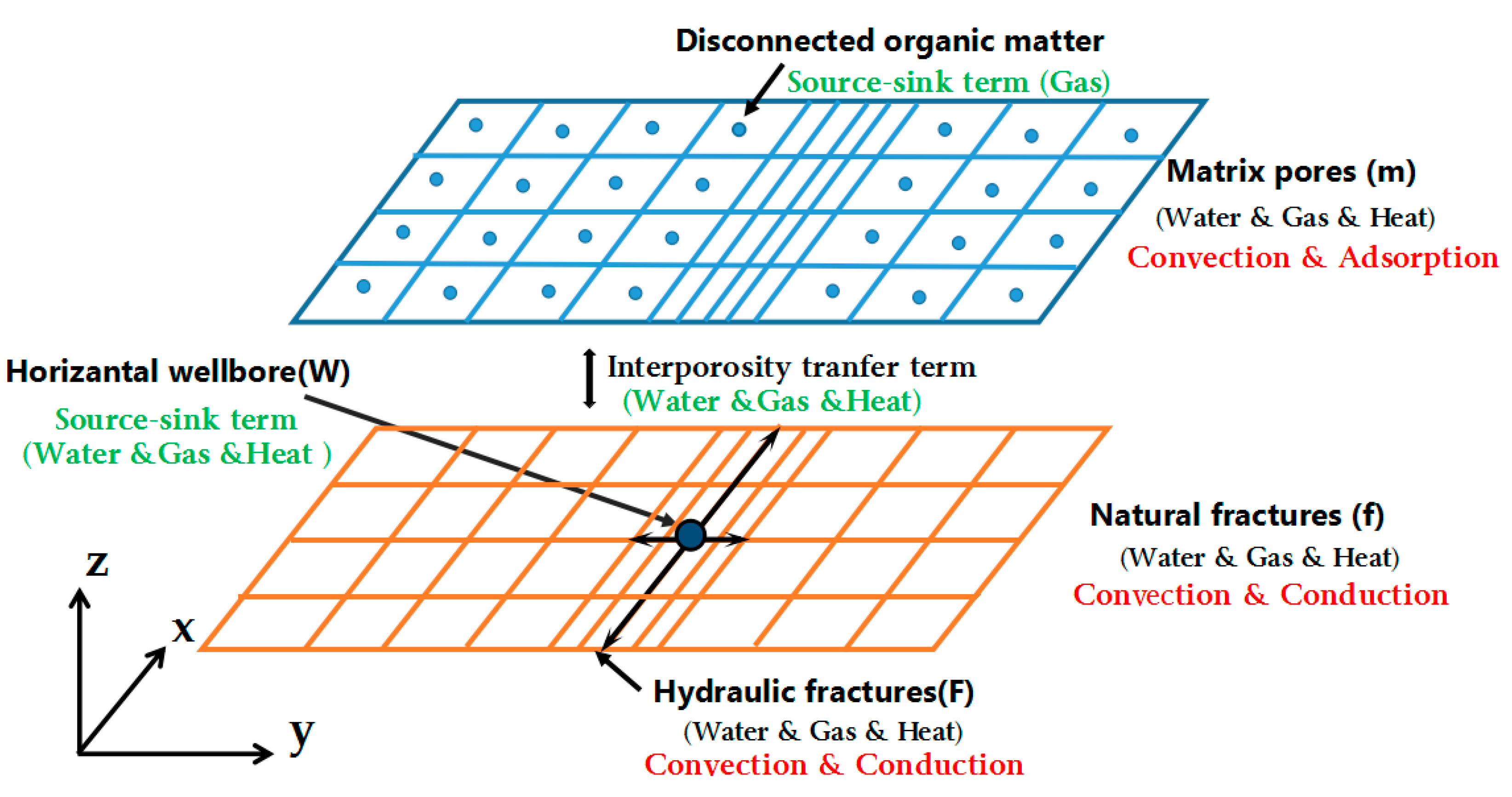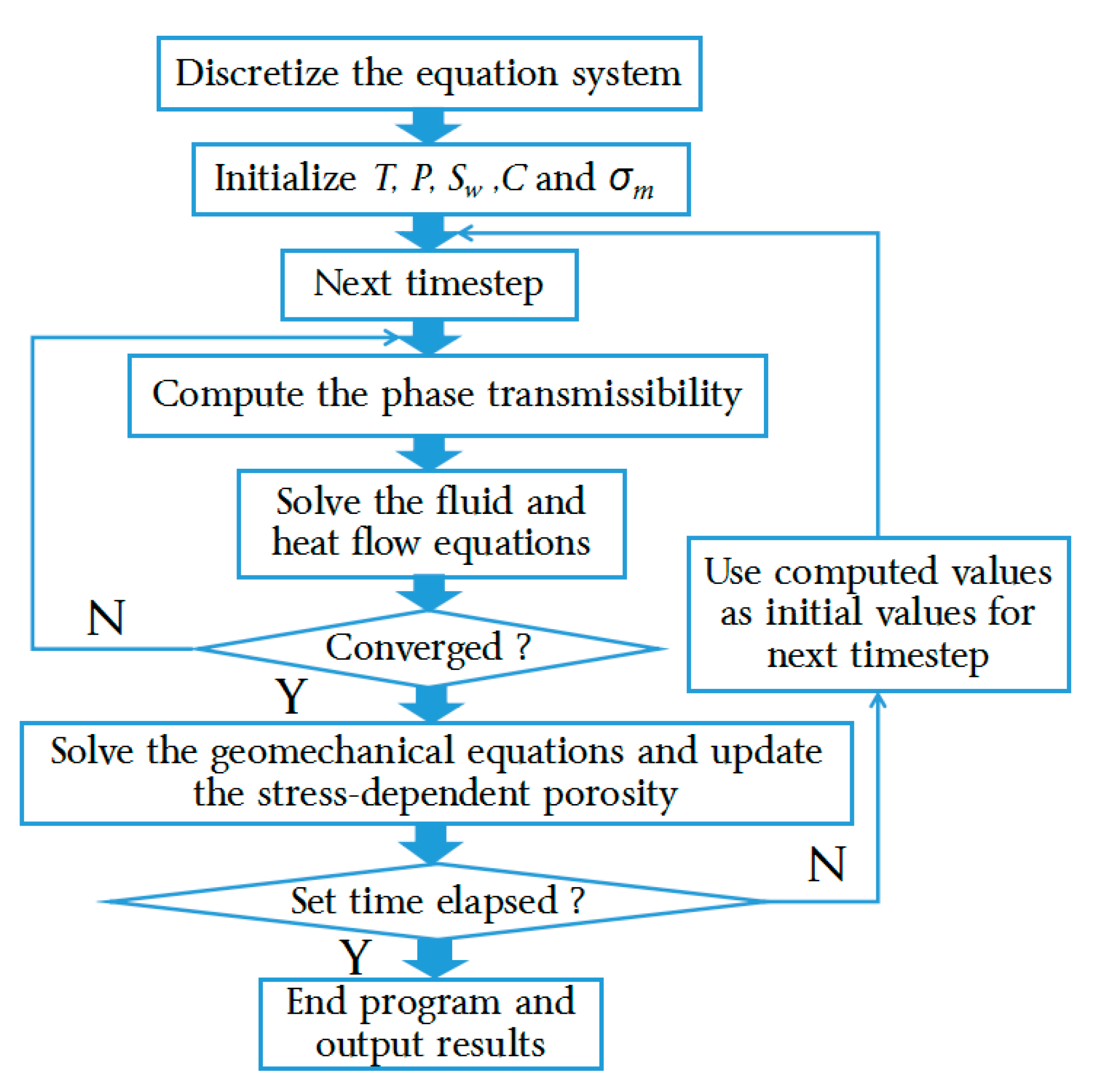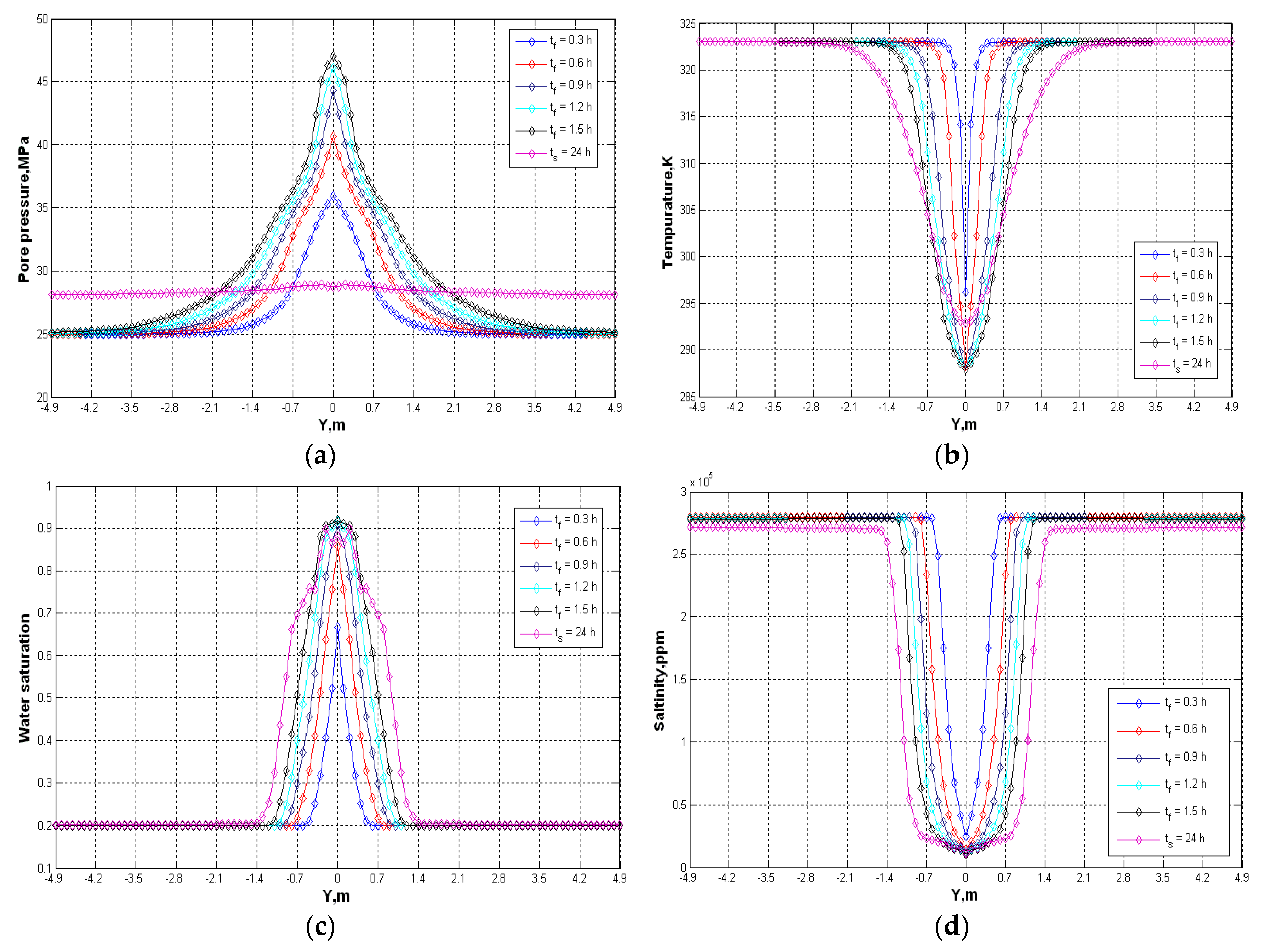Coupled Thermo-Hydro-Mechanical-Chemical Modeling of Water Leak-Off Process during Hydraulic Fracturing in Shale Gas Reservoirs
Abstract
:1. Introduction
2. Chemical-Potential Equilibrium Formulation
2.1. Derivation of Non-Isothermal Chemical Potential Difference for Different Solutions
2.2. Non-Isothermal Chemical Potential Difference between the Slickwater and Formation Brine
3. Mean-Stress Geomechanical Formulation
4. Fluid and Heat Flow Formulation
- (1)
- Fluid Flow in the Hydraulic Fracture
- (2)
- Heat Flow in the Hydraulic Fracture
- (3)
- Fluid Flow in the Natural Fracture
- (4)
- Heat Flow in the Natural Fracture
- (5)
- Fluid Flow in the Matrix
- (6)
- Heat Flow in the Matrix
5. Coupling and Solution of Simulator Equations
6. Numerical Simulation Cases
6.1. Simulation Model Description
6.2. Basecase Simulation Results
6.3. Sensitivity Simulation and Analysis
7. Limitations of the Work
8. Conclusions
- (1)
- During the 1.5 h of fracturing-fluid pumping, water has been leaking from hydraulic fractures to the natural fractures and the matrix, and, during the well shut-in, the leak-off continues. The thermal-osmotic and chemical-osmotic pressures, which are positive driven forces besides the hydraulic pressure difference during the pumping and well shut-in, have aggravated the water leak-off. A multi-field coupled invasion region surrounding the hydraulic fractures in natural fractures and the matrix is created, respectively, during the slickwater injection due to the leak-off mechanism.
- (2)
- After 1.5 h of water injection, the total injection volume from the wellbore to hydraulic fractures is 17,089 m3, of which approximately 9209 m3 leaks into natural fractures and 5900 m3 leaks into the matrix. After the 24-h shut-in, the total leak-off ratio reaches 54.2% and approximately 46.2% of injected water leaks into the matrix.
- (3)
- The four dominating phenomena, i.e., hydraulic pressure, natural-fracture density, chemical osmosis and thermal osmosis, show various influences on fracturing-fluid leak-off. Among them, the hydraulic pressure has the greatest effect, followed by the temperature-difference-induced thermal osmosis and the salt-concentration-difference-induced chemical osmosis. The natural-fracture density is the weakest factor to the water leak-off under this simulation condition, however, its dilation during the hydraulic fracturing can lead to an extra large amount of injected water, which will be stored inside rather than leaked into the matrix.
- (4)
- Results from this study provide a better understanding of the fluid and heat transport mechanism of water-based fracturing-fluids in shale gas reservoirs. We can infer that a shale gas reservoir with low pressure, high temperature, high salinity and high natural-fracture density is highly absorbent, which leads to the high injection capacity and high leak-off volume.
Acknowledgments
Author Contributions
Conflicts of Interest
References
- Penny, G.S.; Pursley, J.T.; Clawson, T.D. Field study of completion fluids to enhance gas production in the Barnett Shale. In Proceedings of the SPE Gas Technology Symposium, Calgary, AB, Canada, 15–17 May 2006. Paper 100434-MS. [Google Scholar]
- Zhong, H. Flow of gas and water in hydraulically fractured shale gas reservoirs. In Proceedings of the EPA HF Workshop, Arlington, VA, USA, 28–29 March 2011. [Google Scholar]
- Roychaudhuri, B.; Tsotsis, T.T.; Jessen, K. An Experimental and Numerical Investigation of Spontaneous Imbibition in Gas Shales. In Proceedings of the SPE Annual Technical Conference and Exhibition, Denver, CO, USA, 30 October–2 November 2011. [Google Scholar]
- Dehghanpour, H.; Zubair, H.A.; Chhabra, A.; Ullah, A. Liquid Intake of Organic Shales. Energy Fuels 2012, 26, 5750–5758. [Google Scholar] [CrossRef]
- Makhanov, K.; Dehghanpour, H.; Kuru, E. An Experimental Study of Spontaneous Imbibition in Horn River Shales. In Proceedings of the SPE Canadian Unconventional Resources Conference, Calgary, AB, Canada, 30 October–1 November 2012. [Google Scholar]
- Dehghanpour, H.; Lan, Q.; Saeed, Y.; Fei, H.; Qi, Z. Spontaneous Imbibition of Brine and Oil in Gas Shales: Effect of Water Adsorption and Resulting Microfractures. Energy Fuels 2013, 27, 3039–3049. [Google Scholar] [CrossRef]
- Lan, Q.; Ghanbari, E.; Dehghanpour, H.; Hawkes, R. Water Loss versus Soaking Time: Spontaneous Imbibition in Tight Rocks. In Proceedings of the SPE/EAGE European Unconventional Conference and Exhibition, Vienna, Austria, 25–27 February 2014. [Google Scholar]
- Fan, Y.; Economides, M.J. Fracturing Fluid Leakoffand Net Pressure Behavior in Frac & Pack Stimulation. In Proceedings of the International Meeting on Petroleum Engineering, Beijing, China, 14–17 November 1995. [Google Scholar]
- Ehlig-Economides, C.A.; Economides, M.J. Water as Proppant. In Proceedings of the SPE Annual Technical Conference and Exhibition, Denver, CO, USA, 30 October–2 November 2011. [Google Scholar]
- Sharma, M.; Agrawal, S. Impact of Liquid Loading in Hydraulic Fractures on Well Productivity. In Proceedings of the SPE Hydraulic Fracturing Technology Conference, Woodlands, TX, USA, 4–6 February 2013. [Google Scholar]
- Williams, B.B. Fluid loss from hydraulically induced fractures. J. Pet. Technol. 1970, 22, 882–888. [Google Scholar] [CrossRef]
- Meyer, B.R.; Jacot, R.H. Implementation of Fracture Calibration Equations for Pressure Dependent Leakoff. In Proceedings of the SPE/AAPG Western Regional Meeting, Long Beach, CA, USA, 19–22 June 2000. [Google Scholar]
- Yew, C.H.; Ma, M.J.; Hill, A.D. A Study of Fluid Leakoff in Hydraulic Fracture Propagation. In Proceedings of the International Oil and Gas Conference and Exhibition, Beijing, China, 7–10 November 2000. [Google Scholar]
- Li, Y.; Guo, J.; Zhao, J. A New Model of Fluid Leakoff in Naturally Fractured Gas Fields and its Effects on Fracture Geometry. In Proceedings of the Canadian International Petroleum Conference, Calgary, AB, Canada, 7–9 June 2005. [Google Scholar]
- Michel, G.; Sigal, R.F.; Civan, F.; Devegowda, D. Effect of Capillary Relaxation on Water Entrapment after Hydraulic Fracturing Stimulation. In Proceedings of the Americas Unconventional Resources Conference, Pittsburgh, PA, USA, 5–7 June 2012. [Google Scholar]
- Jurus, W.J.; Whitson, C.H.; Golan, M. Modeling Water Flow in Hydraulically-Fractured Shale Wells. In Proceedings of the SPE Annual Technical Conference and Exhibition, New Orleans, LA, USA, 30 September–2 October 2013. [Google Scholar]
- Xu, Y.; Fu, Y.; Ezulike, D.O. Modeling Two-Phase Flowback Data Using an Open Tank Model. In Proceedings of the SPE/CSUR Unconventional Resources Conference, Calgary, AB, Canada, 20–22 October 2015. [Google Scholar]
- Zoback, M.D.; Kohli, A.; Das, K.; McClure, M. The Importance of Slow Slip on Faults during Hydraulic Fracturing Stimulation of Shale Gas Reservoirs. In Proceedings of the SPE Americas Unconventional Resources Conference, Richardson, TX, USA, 5–7 June 2012. [Google Scholar]
- Weng, X.; Sesetty, V.; Kresse, O. Investigation of Shear-Induced Permeability in Unconventional Reservoirs. In Proceedings of the 49th US Rock Mechanics/Geomechanics Symposium, San Francisco, CA, USA, 28 June–1 July 2015. [Google Scholar]
- Maxwell, S.C.; Mack, M.; Zhang, D.; Chorney, D.; Goodfellow, S.D. Differentiating Wet and Dry Microseismic EventsInduced during Hydraulic Fracturing. In Proceedings of the Unconventional Resources Technology Conference, San Antonio, TX, USA, 20–22 July 2015. [Google Scholar]
- Bredehoeft, J.D.; Blyth, C.R.; White, W.A.; Maxey, G.B. Possible Mechanism for concentration of Brine in Subsurface Formations. AAPG Bull. 1963, 47, 257–269. [Google Scholar]
- Schimmelmann, A.; Boudou, J.P.; Lewan, M.D. Experimental Controls on D/H and C13/C12 Ratios of Kerogen, Bitumen and Oil during Hydrous Pyrolysis. Org. Geochem. 2001, 32, 1009–1018. [Google Scholar] [CrossRef]
- Mastalerz, M.; Schimmelmann, A. Isotopically Exchangeable Organic Hydrogen in Coal Relates to Thermal Maturity and Maceral Composition. Org. Geochem. 2002, 33, 921–931. [Google Scholar] [CrossRef]
- Fang, C.; Huang, Z.; Wang, Q. Rich-gas Shale Reservoirs Ultra-low Water Saturation Causes and Significance. Nat. Gas Geosci. 2014, 25, 471–476. [Google Scholar]
- Haluszczak, L.O.; Rose, A.W.; Kump, L.R. Geochemical Evaluation of Flowback Brine from Marcellus Gas Wells in Pennsylvania, USA. Appl. Geochem. 2012, 28, 55–61. [Google Scholar] [CrossRef]
- Fakcharoenphol, P.; Kurtoglu, B.; Charoenwongsa, S.; Wu, Y.S. The Effect of Osmotic Pressure on Improve Oil Recovery from Fractured Shale Formations. In Proceedings of the SPE Unconventional Resources Conference, The Woodlands, TX, USA, 1–3 April 2014. [Google Scholar]
- Lomba, E.F.T.; Chenevert, M.E.; Sharma, M.M. The role of osmotic effects in fluid flow through shales. J. Pet. Sci. Eng. 2000, 25, 25–35. [Google Scholar] [CrossRef]
- Rahman, M.M.; Chen, Z.; Rahman, S.S. Experimental Investigation of Shale Membrane Behavior under Tri-Axial Condition. Pet. Sci. Technol. 2005, 23, 1265–1282. [Google Scholar] [CrossRef]
- Wang, J.J.; Rahman, S.S. An Investigation of Fluid Leak-off Due to Osmotic and Capillary Effects and Its Impact on Micro-Fracture Generation during Hydraulic Fracturing Stimulation of Gas Shale. In Proceedings of the EUROPEC, Madrid, Spain, 1–4 June 2015. [Google Scholar]
- Fakcharoenphol, P.; Torcuk, M.; Kazemi, H.; Wu, Y.S. Effect of shut-in time on gas flow rate in hydraulic fractured shale reservoirs. J. Pet. Sci. Eng. 2015, 32, 109–121. [Google Scholar] [CrossRef]
- Wang, F.; Pan, Z.; Lin, H.; Zhang, S. A Chemical Potential Dominated Model for Fracturing-Fluid Flowback Simulation in Hydraulically Fractured Gas Shale. In Proceedings of the SPE Annual Technical Conference and Exhibition, Dubai, UAE, 26–28 September 2016. [Google Scholar]
- Li, X.; Abass, H.; Teklu, T.W. A Shale Matrix Imbibition Model—Interplay between Capillary Pressure and Osmotic Pressure. In Proceedings of the SPE Annual Technical Conference and Exhibition, Dubai, UAE, 26–28 September 2016. [Google Scholar]
- Dirksen, D. Thermo-osmosis through compacted saturated clay membranes. Soil Sci. Soc. Am. Proc. 1969, 33, 821–826. [Google Scholar] [CrossRef]
- Ghassemi, A.; Diek, A. Porothemoelasticity for swelling shales. J. Pet. Sci. Eng. 2002, 34, 123–135. [Google Scholar] [CrossRef]
- Zheng, L.; Samper, J.; Montenegro, L. A coupled THC model of the FEBEX in Situ Test with Bentonite Swelling and Chemical and Thermal Osmosis. J. Contam. Hydrol. 2011, 126, 45–60. [Google Scholar] [CrossRef] [PubMed]
- Eshkalak, M.O.; Aybar, U.; Sepehrnoori, K. An Integrated Reservoir Model for Unconventional Resources, Coupling Pressure Dependent Phenomena. In Proceedings of the SPE Eastern Regional Meeting, Charleston, WV, USA, 21–23 October 2014. [Google Scholar]
- Wang, F.; Pan, Z.; Zhang, S. Modeling Water Leak-off Behavior in Hydraulically Fractured Gas Shale under Multi-mechanism Dominated Conditions. Transp. Porous Media 2017, 118, 177–200. [Google Scholar] [CrossRef]
- Han, D.; Gao, Z.; Gao, P. Physical Chemistry; Higher Education Press: Beijing, China, 2009. [Google Scholar]
- Chen, F.; Wei, M.; Ye, Y.; Yuan, W. Calculation of Chemical Potential in Dilute Solution and Derivation of the Osmosis Pressure Equation. Univ. Chem. 2015, 30, 63–67. [Google Scholar]
- Oort, E.V.; Hale, A.H.; Mody, F.K.; Roy, S. Transport in Shales and the Design of Improved Water-Based Shale Drilling Fluids. SPE Drill. Complet. 1996, 11, 137–146. [Google Scholar] [CrossRef]
- Ewy, R.T.; Stankovich, R.J. Pore Pressure Change Due to Shale-Fluid Interactions: Measurements under Simulated Wellbore Conditions. In Proceedings of the Pacific Rocks 2000, Fourth North American Rock Mechanics Symposium, Seattle, WA, USA, 31 July–3 August 2000; pp. 147–154. [Google Scholar]
- Mody, F.K.; Tare, U.A.; Tan, C.P.; Drummond, C.J.; Wu, B. Development of Novel Membrane Efficient Water-Based Drilling Fluids through Fundamental Understanding of Osmotic Membrane Generation in Shales. In Proceedings of the SPE Annual Technical Conference and Exhibition, San Antonio, TX, USA, 29 September–2 October 2002. [Google Scholar]
- Schlemmer, R.; Friedheim, J.E.; Growcock, F.B.; Bloys, J.B.; Headley, J.A. Chemical Osmosis, Shale, and Drilling Fluids. SPE Drill. Complet. 2003, 18, 318–331. [Google Scholar] [CrossRef]
- McTigue, D.F. Thermoelastic Response of Fluid-saturated Porous Rock. J. Geophys. Res. 1986, 91, 9533–9542. [Google Scholar] [CrossRef]
- Winterfeld, P.H.; Wu, Y. Simulation of Coupled Thermal-Hydrological-Mechanical Phenomena in Porous and Fractured Media. SPE J. 2016, 21, 1041–1049. [Google Scholar] [CrossRef]
- McLennan, J.; Potocki, D. Hydraulic Fracturing Complexity: Interaction between Hydraulic and Natural Fractures. In Proceedings of the AAPG Workshop: Geomechanics and Reservoir Characterization of Shales and Carbonates, Baltimore, MD, USA, 16–17 July 2013. [Google Scholar]
- Tang, H.; Killough, J.E.; Heidari, Z.; Sun, Z. A New Technique To Characterize Fracture Density by Use of Neutron Porosity Logs Enhanced by Electrically Transported Contrast Agents. In Proceedings of the SPE Annual Technical Conference and Exhibition, Dubai, UAE, 26–28 September 2016. [Google Scholar]
- Biot, M.A.; Willis, D.G. The Elastic Coefficients of the Theory of Consolidation. J. Appl. Mech. 1957, 15, 594–601. [Google Scholar]
- Bybee, K. Non-Darcy Flow in Hydraulic Fractures. J. Pet. Technol. 2006, 58, 58–59. [Google Scholar] [CrossRef]
- Bian, X.; Zhang, S.; Zhang, J.; Wang, F. A New Method to Optimize the Fracture Geometry of a Frac-packed Well in Unconsolidated Sandstone Heavily Oil Reservoirs. Sci. China Technol. Sci. 2012, 55, 1725–1731. [Google Scholar] [CrossRef]
- Kazemi, H.; Gilmanc, J.R.; Elsharkawy, A.M. Analytical and Numerical Solution of Oil Recovery from Fractured Reservoirs with Empirical Transfer Functions. SPE Reserv. Eng. 1992, 7, 219–227. [Google Scholar] [CrossRef]
- Silin, D.; Kneafsey, T.J. Shale Gas: Nanometer-Scale Observations and Well Modeling. J. Can. Pet. Technol. 2012, 51, 464–475. [Google Scholar] [CrossRef]
- Gilman, J.R. Practical Aspects of Simulation of Fractured Reservoirs. In Proceedings of the International Forum on Reservoir Simulation, Buhl, Germany, 23–27 June 2003. [Google Scholar]
- Yan, B.; Mi, L.; Wang, Y. Mechanistic Simulation Workflow in Shale Gas Reservoirs. In Proceedings of the SPE Reservoir Simulation Conference, Montgomery, TX, USA, 20–22 February 2017. [Google Scholar]
- Lee, M. Modified Biot-Gassmann theory for calculating elastic velocities for unconsolidated and consolidated sediments. Mar. Geophys. Res. 2002, 23, 403–412. [Google Scholar] [CrossRef]
- Chen, Z.; Xue, C.; Jiang, T.; Qin, Y. Proposals for the Application of Fracturing by Stimulated Reservoir Volume (SRV) in Shale Gas Wells in China. Nat. Gas Ind. 2010, 30, 30–32. [Google Scholar]
- Garavito, A.M.; Kooi, H.; Neuzil, C.E. Numerical modeling of a long-term in situ chemical osmosis experiment in the Pierre Shale, South Dakota. Adv. Water Resour. 2006, 29, 481–492. [Google Scholar] [CrossRef]
- Ghassemi, A.; Tao, Q.; Diek, A. Influence of coupled chemo-poro-thermoelastic processes on pore pressure and stress distributions around a wellbore in swelling shale. J. Pet. Eng. 2009, 67, 57–64. [Google Scholar] [CrossRef]
- Gdanski, R.D.; Fulton, D.D.; Chen, C. Fracture-Face-Skin Evolution during Cleanup. SPE Prod. Oper. 2009, 24, 22–34. [Google Scholar] [CrossRef]
- Zhang, D.; Yang, T. Environmental impacts of hydraulic fracturing in shale gas development in the United States. Pet. Explor. Dev. 2015, 42, 801–807. [Google Scholar] [CrossRef]






| Parameter, Symbol | Value | Parameter, Symbol | Value |
|---|---|---|---|
| Initial mean stress, σmi | 52 MPa | Initial porosity, φiF, φif , φim | 0.15, 0.015, 0.05 |
| Initial reservoirpressure, pi | 25 MPa | Stress-dependent coefficient, ckF, ckf, ckm | 0.05, 0.12, 10−5 MPa−1 |
| Reservoir temperature, T | 323 K | Initial water saturation, SwiF, Swif, Swim | 0.2, 0.2, 0.2 |
| Poisson’s ratio, ν | 0.2 | Irreducible water saturation, Sw,irrF, Sw,irrf, Sw,irrm | 0.1, 0.2, 0.6 |
| Water density, ρw | 1000 kg/m3 | Permeability, kF, kf, km | 100 md, 10,000 nd, 100 nd |
| Water viscosity, ηw | 0.8 mPa∙s | Injected water salinity, Cinj | 1000 ppm |
| Water compressibility, cw | 4 × 10−4 MPa−1 | Biot coefficient, βF, βf, βm | 0.76, 0.06, 0.18 |
| Natural fracture density, nf | 5 | Initial salinity, CiF, Cif, Cim | 1000, 10,000, 280,000 ppm |
| Membrane efficiency, λ | 0.06 | Volume proportion of source rock, Sk | 0.1 |
| Langmuir’s pressure, pL | 5.8 MPa | Ideal gas constant, R | 8.314 J/(mol·K) |
| Rock density, ρr | 2560 kg/m3 | Langmuir’s volume, VL | 3.32 × 10−3 m3/kg |
| Gas compressibility, cg | 0.03 MPa−1 | Gas density at standard condition, ρgsc | 0.77 kg/m3 |
| Gas viscosity, ηg | 0.058 mPa·s | Partial molar volume of water, Vw,m | 18.02 × 10−6 m3/mol |
| Injected water temperature, Tf | 288 K | Partial molar entropy of water, Sw,m | 69.91 J/(mol·K) |
| Heat capacity of rock, Cr | 774 J/(kg·K) | Heat capacity of fluid, Cw | 4200 J/(kg·K) |
| Solid bulk modulus Kr | 11.44 GPa | Thermal diffusivity coefficient, De | 1.6 × 10−6 m2/s |
| Basecase | Pi = 30 MPa | Pi = 36 MPa | Ti = 333 K | Ti = 343 K | Cim = 180,000 | Cim = 18,000 | nf = 1 | nf = 30 | |
|---|---|---|---|---|---|---|---|---|---|
| (m3) | 17,089 | 12,317 | 7627 | 17,713 | 18,145 | 17,086 | 17,078 | 16,054 | 20,122 |
| (m3) | 9209 | 6380 | 3662 | 9561 | 9814 | 9206 | 9199 | 8649 | 10,965 |
| (m3) | 5900 | 4086 | 2343 | 6194 | 6399 | 5878 | 5853 | 5542 | 6348 |
© 2017 by the authors. Licensee MDPI, Basel, Switzerland. This article is an open access article distributed under the terms and conditions of the Creative Commons Attribution (CC BY) license (http://creativecommons.org/licenses/by/4.0/).
Share and Cite
Wang, F.; Li, B.; Zhang, Y.; Zhang, S. Coupled Thermo-Hydro-Mechanical-Chemical Modeling of Water Leak-Off Process during Hydraulic Fracturing in Shale Gas Reservoirs. Energies 2017, 10, 1960. https://doi.org/10.3390/en10121960
Wang F, Li B, Zhang Y, Zhang S. Coupled Thermo-Hydro-Mechanical-Chemical Modeling of Water Leak-Off Process during Hydraulic Fracturing in Shale Gas Reservoirs. Energies. 2017; 10(12):1960. https://doi.org/10.3390/en10121960
Chicago/Turabian StyleWang, Fei, Baoman Li, Yichi Zhang, and Shicheng Zhang. 2017. "Coupled Thermo-Hydro-Mechanical-Chemical Modeling of Water Leak-Off Process during Hydraulic Fracturing in Shale Gas Reservoirs" Energies 10, no. 12: 1960. https://doi.org/10.3390/en10121960
APA StyleWang, F., Li, B., Zhang, Y., & Zhang, S. (2017). Coupled Thermo-Hydro-Mechanical-Chemical Modeling of Water Leak-Off Process during Hydraulic Fracturing in Shale Gas Reservoirs. Energies, 10(12), 1960. https://doi.org/10.3390/en10121960




